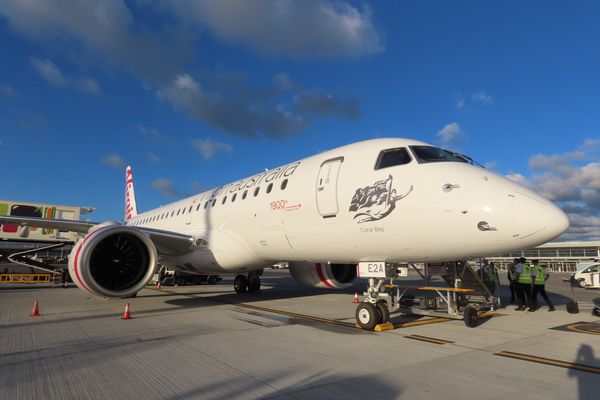An Austrian Airlines flight suffered significant damage from hail on Sunday while approaching Vienna Airport, Austria from Palma De Mallorca, Spain.
Flight OS434, a 23-year-old Airbus A320, encountered the storm at an estimated altitude of 6000 meters, one hour and fifty-nine minutes in the skies, causing damage to its nose and windshield.

According to the Austrian Airlines, the aircraft encountered a thunderstorm cell on approach to Vienna.
"The cockpit crew said it was not visible to the weather radar," said the airline representative.
Meanwhile, the airline mentioned that a necessary inspection would be conducted on the aircraft.
"The Austrian Airlines technical team has already been entrusted with the specific damage assessment of the aircraft in question," the airline noted.
Despite the incident, no injuries or casualties were reported, and the pilots managed to land safely at 1759 local time. The airline assures that the safety of the passengers will always be a top priority.
Austria Airlines AG, the flag carrier of Austria, flies to more than 120 international year-round and seasonal destinations in 55 countries.
What Are Hailstorms and How Can They Affect the Flights?
According to the National Severe Storms Laboratory, hail is a form of precipitation consisting of solid ice that forms inside thunderstorm updrafts. Although aircraft components are designed to endure various impacts like hailstones, pilots tend to avoid them due to their significant effect on the aircraft.
Hailstorms have caused fuselage and wing breakage. However, emergency landings, flight delays and cancellations, and air traffic rerouting are the more common occurrences.
Last month, a similar incident happened to the Vistara Aircraft en route to Delhi from Bhubaneswar, where it was forced to make an emergency landing shortly after its takeoff.

A similar hail strike damaged parts of Atlas Air Boeing 777 on April 28, 2024, over Hong Kong, causing significant harm to the aircraft's radome, vertical stabilizer, and fuselage.
1985 Air Crash
In 1985, Delta Air Lines Flight 191, crashed at Dallas/Fort Worth International Stadium due to a microburst, a strong downdraft associated with thunderstorms.

While it wasn't solely a hailstorm, the severe weather conditions, including hail, contributed to the aircraft's crash over one mile short of the runway.
This unfortunate event resulted in the loss of 137 lives out of the 163 people on board.
The National Transportation Safety Board (NTSB) conducted a thorough investigation into the accident and found that the Lack of Wind Shear Detection Technology and the Weather and Wind Shear also contributed to the disaster.
The levels of air travel safety have drastically improved since the Flight 191 incident. The aviation industry has significantly enhanced its wind shear detection, weather radar improvements, air traffic control procedures and flight operations.
Maiden Brazil: Virgin Australia Welcomes the Iconic Embraer E2 » China Eastern Inaugurates New World's Longest Flight »
Comments (0)
Add Your Comment
SHARE
TAGS
NEWS Austrian Airlines FlightOS434 AirbusA320 hailstormRECENTLY PUBLISHED
 Maiden Brazil: Virgin Australia Welcomes the Iconic Embraer E2
Known for its aging intrastate fleets and unmatched concentration of Fokker 100s, Perth Airport has been a time capsule for aviation enthusiasts. Now, Virgin Australia Regional Airlines is breaking tradition with the arrival of the cutting-edge Embraer E190-E2, ushering in a new era for Western Australian air travel.
TRIP REPORTS
READ MORE »
Maiden Brazil: Virgin Australia Welcomes the Iconic Embraer E2
Known for its aging intrastate fleets and unmatched concentration of Fokker 100s, Perth Airport has been a time capsule for aviation enthusiasts. Now, Virgin Australia Regional Airlines is breaking tradition with the arrival of the cutting-edge Embraer E190-E2, ushering in a new era for Western Australian air travel.
TRIP REPORTS
READ MORE »
 China Eastern Inaugurates New World's Longest Flight
China Eastern recently launched its longest flight, a route connecting Shanghai and Buenos Aires via a stopover in Auckland. Inaugurated in December, this was advertised as a “Direct Air Link” between Asia and South America.
ROUTES
READ MORE »
China Eastern Inaugurates New World's Longest Flight
China Eastern recently launched its longest flight, a route connecting Shanghai and Buenos Aires via a stopover in Auckland. Inaugurated in December, this was advertised as a “Direct Air Link” between Asia and South America.
ROUTES
READ MORE »
 Essential Legal Tips for Tourists Chartering a Yacht in Dubai
Discover how yacht rentals in Dubai are regulated and learn what every tourist should know about contracts, insurance, and taxes before setting sail.
TRIP REPORTS
READ MORE »
Essential Legal Tips for Tourists Chartering a Yacht in Dubai
Discover how yacht rentals in Dubai are regulated and learn what every tourist should know about contracts, insurance, and taxes before setting sail.
TRIP REPORTS
READ MORE »



